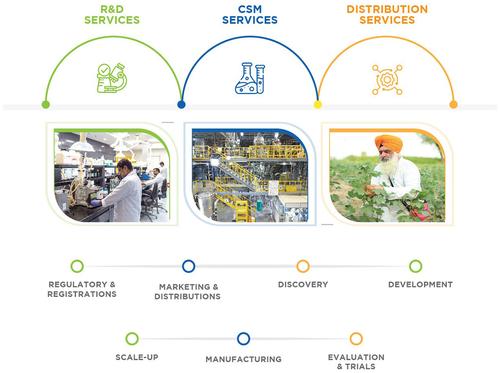当前位置:
X-MOL 学术
›
Pest Manag. Sci.
›
论文详情
Our official English website, www.x-mol.net, welcomes your
feedback! (Note: you will need to create a separate account there.)
Enhancing collaboration quotient in crop protection research and development – multi‐disciplinary cross‐learning to promote sustainability
Pest Management Science ( IF 3.8 ) Pub Date : 2024-11-19 , DOI: 10.1002/ps.8540 Sunil Kumar Mandal, Mayank Singhal
Pest Management Science ( IF 3.8 ) Pub Date : 2024-11-19 , DOI: 10.1002/ps.8540 Sunil Kumar Mandal, Mayank Singhal

|
After a decade of consolidation with a focus on top market players, global crop protection research is undergoing a paradigm transition by integrating new cutting‐edge technologies originating from established and new research organizations. Both development and distribution organizations are working together to make these innovations available to the global farming community. For this, excellent crop protection products are in demand, creating value for farmers and society with superior biological performance and at the same time very high product safety profiles. However, the enormous constraints researchers are exposed to, require the discovery and development of innovative solutions in the shortest possible time frame, while embracing environmental, social, and governance (ESG) objectives as the new normal across the whole industry. Today, fully integrated research and development (R&D) companies are addressing the whole plethora of agrochemistry, biologicals and plant health products, organic farming, seeds and traits, new application technologies, digital farming, improved diagnostics, artificial intelligence (AI), and machine learning (ML)‐based approaches. However, there is still a strong need for further innovations from a wide range of sources. Targeted collaboration across various market players is key to combining required activities. This mandates a high level of discipline to frame the proprietary and knowledge environment across the industry. Furthermore, the cooperation of industry and academia will enable an extra push for innovation in the crop protection landscape. Current trends and suggestions are given of how collaborations need to be framed within the industry as well as within the public sector. © 2024 Society of Chemical Industry.
中文翻译:

提高作物保护研究和开发的合作商数 – 多学科交叉学习促进可持续发展
经过十年的整合,重点关注顶级市场参与者,全球作物保护研究正在通过整合源自成熟和新研究机构的新技术而经历范式转变。开发和分销组织正在共同努力,将这些创新提供给全球农业社区。为此,需要优质的作物保护产品,以卓越的生物性能和非常高的产品安全性为农民和社会创造价值。然而,研究人员面临的巨大限制,需要在尽可能短的时间内发现和开发创新解决方案,同时将环境、社会和治理 (ESG) 目标作为整个行业的新常态。如今,完全整合的研发 (R&D) 公司正在处理大量农业化学、生物制剂和植物保健品、有机农业、种子和性状、新应用技术、数字农业、改进的诊断、人工智能 (AI) 和基于机器学习 (ML) 的方法。然而,仍然强烈需要来自广泛来源的进一步创新。跨不同市场参与者的针对性合作是合并所需活动的关键。这需要高水平的纪律来构建整个行业的专有和知识环境。此外,工业界和学术界的合作将进一步推动作物保护领域的创新。本文就如何在行业和公共部门内部构建合作提供了当前的趋势和建议。© 2024 化工学会.
更新日期:2024-11-19
中文翻译:

提高作物保护研究和开发的合作商数 – 多学科交叉学习促进可持续发展
经过十年的整合,重点关注顶级市场参与者,全球作物保护研究正在通过整合源自成熟和新研究机构的新技术而经历范式转变。开发和分销组织正在共同努力,将这些创新提供给全球农业社区。为此,需要优质的作物保护产品,以卓越的生物性能和非常高的产品安全性为农民和社会创造价值。然而,研究人员面临的巨大限制,需要在尽可能短的时间内发现和开发创新解决方案,同时将环境、社会和治理 (ESG) 目标作为整个行业的新常态。如今,完全整合的研发 (R&D) 公司正在处理大量农业化学、生物制剂和植物保健品、有机农业、种子和性状、新应用技术、数字农业、改进的诊断、人工智能 (AI) 和基于机器学习 (ML) 的方法。然而,仍然强烈需要来自广泛来源的进一步创新。跨不同市场参与者的针对性合作是合并所需活动的关键。这需要高水平的纪律来构建整个行业的专有和知识环境。此外,工业界和学术界的合作将进一步推动作物保护领域的创新。本文就如何在行业和公共部门内部构建合作提供了当前的趋势和建议。© 2024 化工学会.


















































 京公网安备 11010802027423号
京公网安备 11010802027423号